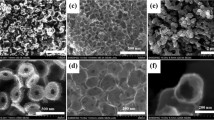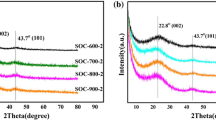Abstract
We demonstrate a multi-template carbonization approach to produce nanoporous carbon, without any complicated activation process. The mass ratio of Mg citrate, zinc metal, and Zn(OAc)2·2H2O as well as the carbonization temperature play decisive roles in determining the carbon pore structures. The electrochemical performances were investigated in a two-electrode system, using a mixture of 1-ethyl-3-methyl imidazolium tetrafluoroborate and acetonitrile as electrolyte. More importantly, the cell configuration was measured at different operation temperatures of 25/50/80 °C. The carbon-7# sample that was obtained using Mg citrate, zinc metal, and Zn(OAc)2·2H2O as starting materials (with a mass ratio between them of 1:1:1) at 800 °C delivers the best electrochemical behavior mostly reflected in its large Brunauer–Emmett–Teller (BET) surface area of 1,776.3 m2 g−1, high pore volume of 3.82 cm3 g−1, and hierarchical pore size distribution. It can exhibit good cycling stabilities and large specific capacitances of 152.2, 243.5, and 279.4 F g−1, respectively, at the operation temperatures of 25/50/80 °C. The corresponding energy densities are as high as 47.5, 75.9, and 87.2 Wh kg−1, respectively, in the case of power energy of 1.5 kW kg−1. The operation temperatures of 25/50/80 °C revealed in the present work can greatly broaden the supercapacitor application of nanoporous carbons under extreme circumstances.





Similar content being viewed by others
References
Frackowiak E (2007) Carbon materials for supercapacitor application. Phys Chem Chem Phys 9:1774–1785
Zhang LL, Zhao XS (2009) Carbon-based materials as supercapacitor electrodes. Chem Soc Rev 38:2520–2531
Zhai Y, Dou Y, Zhao D, Fulvio PF, Mayes RT, Dai S (2011) Carbon materials for chemical capacitive energy storage. Adv Mater 23:4828–4850
Simon P, Gogotsi Y (2008) Materials for electrochemical capacitors. Nat Mater 7:845–854
Xing W, Huang CC, Zhuo SP, Yuan X, Wang GQ, Hulicova-Jurcakova D, Yan ZF, Lu GQ (2008) Hierarchical porous carbons with high performance for supercapacitor electrodes. Carbon 47:1715–1722
Zhong H, Xu F, Li Z, Fu R, Wu D (2013) High-energy supercapacitors based on hierarchical porous carbon with an ultrahigh ion-accessible surface area in ionic liquid electrolytes. Nanoscale 5:4678–4682
Qie L, Chen W, Xu H, Xiong X, Jiang Y, Zou F, Hu X, Xin Y, Zhang Z, Huang Y (2013) Synthesis of functionalized 3D hierarchical porous carbon for high-performance supercapacitors. Energy Environ Sci 6:2497–2504
Amali AJ, Sun JK, Xu Q (2014) From assembled metal-organic framework nanoparticles to hierarchically porous carbon for electrochemical energy storage. Chem Commun 50:1519–1522
Ren TZ, Liu L, Zhang YY, Yuan ZY (2013) Hierarchical mesoporous carbon materials: preparation by direct tri-constituent co-assembly and the electrochemical performance. J Solid State Electrochem 17:927–935
Ren TZ, Liu L, Zhang YY, Yuan ZY (2013) Nitric acid oxidation of ordered mesoporous carbons for use in electrochemical supercapacitors. J Solid State Electrochem 17:2223–2233
Kyotani T, Sonobe N, Tomita A (1988) Formation of highly orientated graphite from polyacrylonitrile by using a two-dimensional space between montmorillonite lamellae. Nature 331:331–333
Nishihara H, Kyotani T (2012) Templated nanocarbons for energy storage. Adv Mater 24:4473–4498
Xia Y, Yang Z, Mokaya R (2010) Templated nanoscale porous carbons. Nanoscale 2:639–659
Petkovich ND, Stein A (2013) Controlling macro- and mesostructures with hierarchical porosity through combined hard and soft templating. Chem Soc Rev 42:3721–3739
Chen XY, Chen C, Zhang ZJ, Xie DH (2013) Gelatin-derived nitrogen-doped porous carbon via a dual-template carbonization method for high performance supercapacitors. J Mater Chem A 1:10903–10911
Chen XY, Chen C, Zhang ZJ, Xie DH (2013) High performance porous carbon through hard–soft dual templates for supercapacitor electrodes. J Mater Chem A 1:7379–7383
Morishita T, Tsumura T, Toyoda M, Przepiórski J, Morawski AW, Konno H, Inagaki M (2010) A review of the control of pore structure in MgO-templated nanoporous carbons. Carbon 48:2690–2707
Lin CC, Li YY (2009) Synthesis of ZnO nanowires by thermal decomposition of zinc acetate dihydrate. Mater Chem Phys 113:334–337
Chen XY, Chen C, Zhang ZJ, Xie DH (2013) A general approach for producing nanoporous carbon, especially as evidenced for the case of adipic acid and zinc. J Mater Chem A 1:14919–14926
Zhu Y, Murali S, Stoller MD, Ganesh KJ, Cai W, Ferreira PJ, Pirkle A, Wallace RM, Cychosz KA, Thommes M, Su D, Stach EA, Ruoff RS (2011) Carbon-based supercapacitors produced by activation of graphene. Science 332:1537–1541
Okpalugo TIT, Papakonstantinou P, Murphy H, McLaughlin J, Brown NMD (2005) High resolution XPS characterization of chemical functionalised MWCNTs and SWCNTs. Carbon 43:153–161
Shen W, Li Z, Liu Y (2008) Surface chemical functional groups modification of porous carbon. Recent Patents Chem Eng 1:27–40
Heise HM, Kuckuk R, Ojha AK, Srivastava A, Srivastava V, Asthana BP (2009) Characterisation of carbonaceous materials using Raman spectroscopy: a comparison of carbon nanotube filters, single- and multi-walled nanotubes, graphitised porous carbon and graphite. J Raman Spectrosc 40:344–353
Jänes A, Kurig H, Lust E (2007) Characterisation of activated nanoporous carbon for supercapacitor electrode materials. Carbon 45:1226–1233
Chu PK, Li L (2006) Characterization of amorphous and nanocrystalline carbon films. Mater Chem Phys 96:253–277
Stoller MD, Park S, Zhu Y, An J, Ruoff RS (2008) Graphene-based ultracapacitors. Nano Lett 8:3498–3502
Simon P, Gogotsi Y (2013) Capacitive energy storage in nanostructured carbon-electrolyte systems. Acc Chem Res 46:1094–1103
Futaba DN, Hata K, Yamada T, Hiraoka T, Hayamizu Y, Kakudate Y, Tanaike O, Hatori H, Yumura M, Iijima S (2006) Shape-engineerable and highly densely packed single-walled carbon nanotubes and their application as super-capacitor electrodes. Nat Mater 5:987–994
Chen XY, He YY, Song H, Zhang ZJ (2014) Structure and electrochemical performance of highly nanoporous carbons from benzoate-metal complexes by a template carbonization method for supercapacitor application. Carbon 72:410–420
Chen XY, Song H, Zhang ZJ, He YY (2014) A rational template carbonization method for producing highly porous carbon for supercapacitor application. Electrochim Acta 117:55–61
Acknowledgments
This work was financially supported by the National Natural Science Foundation of China (21101052), China Postdoctoral Science Foundation (20100480045), and the University Natural Science Research Project of Anhui Province (KJ2013B209).
Author information
Authors and Affiliations
Corresponding authors
Electronic supplementary material
Below is the link to the electronic supplementary material.
ESM 1
(DOC 5,126 kb)
Rights and permissions
About this article
Cite this article
Chen, X.Y., He, Y.Y., Song, H. et al. A multi-template carbonization approach to hierarchically nanoporous carbon for high-performance supercapacitors. J Solid State Electrochem 19, 179–186 (2015). https://doi.org/10.1007/s10008-014-2593-x
Received:
Revised:
Accepted:
Published:
Issue Date:
DOI: https://doi.org/10.1007/s10008-014-2593-x




